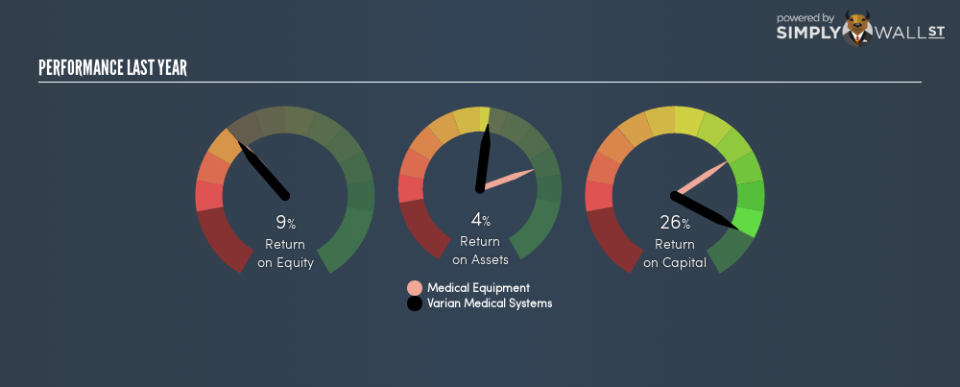Here’s What Varian Medical Systems, Inc.’s (NYSE:VAR) ROCE Can Tell Us

Today we’ll look at Varian Medical Systems, Inc. (NYSE:VAR) and reflect on its potential as an investment. Specifically, we’ll consider its Return On Capital Employed (ROCE), since that will give us an insight into how efficiently the business can generate profits from the capital it requires.
First, we’ll go over how we calculate ROCE. Next, we’ll compare it to others in its industry. Last but not least, we’ll look at what impact its current liabilities have on its ROCE.
Understanding Return On Capital Employed (ROCE)
ROCE measures the ‘return’ (pre-tax profit) a company generates from capital employed in its business. In general, businesses with a higher ROCE are usually better quality. Ultimately, it is a useful but imperfect metric. Author Edwin Whiting says to be careful when comparing the ROCE of different businesses, since ‘No two businesses are exactly alike.’
So, How Do We Calculate ROCE?
Analysts use this formula to calculate return on capital employed:
Return on Capital Employed = Earnings Before Interest and Tax (EBIT) ÷ (Total Assets – Current Liabilities)
Or for Varian Medical Systems:
0.26 = US$500m ÷ (US$3.3b – US$1.3b) (Based on the trailing twelve months to September 2018.)
Therefore, Varian Medical Systems has an ROCE of 26%.
See our latest analysis for Varian Medical Systems
Want to help shape the future of investing tools and platforms? Take the survey and be part of one of the most advanced studies of stock market investors to date.
Is Varian Medical Systems’s ROCE Good?
ROCE is commonly used for comparing the performance of similar businesses. Using our data, we find that Varian Medical Systems’s ROCE is meaningfully better than the 11% average in the Medical Equipment industry. We would consider this a positive, as it suggests it is using capital more effectively than other similar companies. Setting aside the comparison to its industry for a moment, Varian Medical Systems’s ROCE in absolute terms currently looks quite high.
Our data shows that Varian Medical Systems currently has an ROCE of 26%, compared to its ROCE of 19% 3 years ago. This makes us think about whether the company has been reinvesting shrewdly.
It is important to remember that ROCE shows past performance, and is not necessarily predictive. ROCE can be deceptive for cyclical businesses, as returns can look incredible in boom times, and terribly low in downturns. ROCE is, after all, simply a snap shot of a single year. What happens in the future is pretty important for investors, so we have prepared a free report on analyst forecasts for Varian Medical Systems.
What Are Current Liabilities, And How Do They Affect Varian Medical Systems’s ROCE?
Current liabilities are short term bills and invoices that need to be paid in 12 months or less. Due to the way the ROCE equation works, having large bills due in the near term can make it look as though a company has less capital employed, and thus a higher ROCE than usual. To counter this, investors can check if a company has high current liabilities relative to total assets.
Varian Medical Systems has total liabilities of US$1.3b and total assets of US$3.3b. As a result, its current liabilities are equal to approximately 41% of its total assets. A medium level of current liabilities boosts Varian Medical Systems’s ROCE somewhat.
What We Can Learn From Varian Medical Systems’s ROCE
Despite this, it reports a high ROCE, and may be worth investigating further. You might be able to find a better buy than Varian Medical Systems. If you want a selection of possible winners, check out this free list of interesting companies that trade on a P/E below 20 (but have proven they can grow earnings).
I will like Varian Medical Systems better if I see some big insider buys. While we wait, check out this free list of growing companies with considerable, recent, insider buying.
To help readers see past the short term volatility of the financial market, we aim to bring you a long-term focused research analysis purely driven by fundamental data. Note that our analysis does not factor in the latest price-sensitive company announcements.
The author is an independent contributor and at the time of publication had no position in the stocks mentioned. For errors that warrant correction please contact the editor at editorial-team@simplywallst.com.

